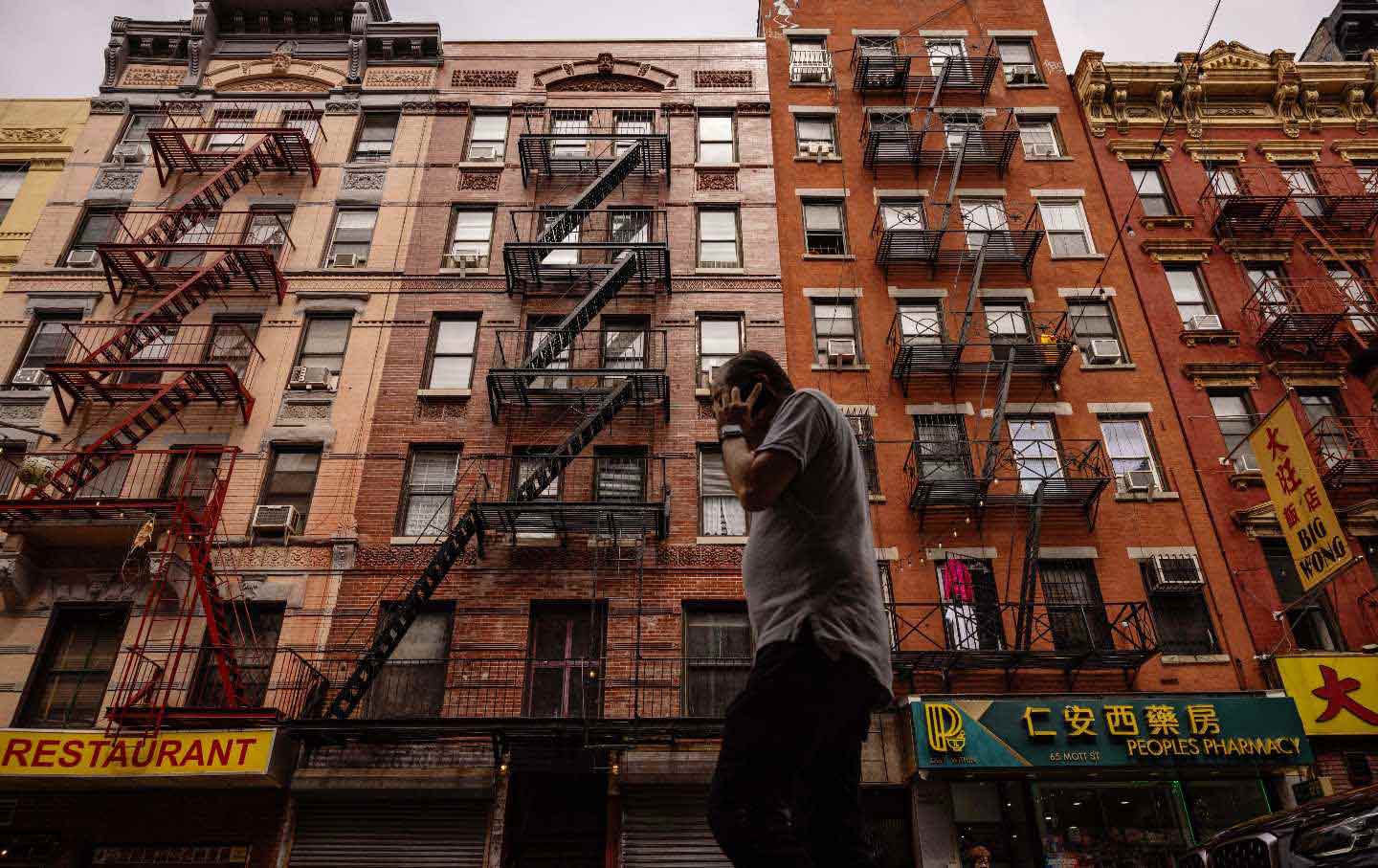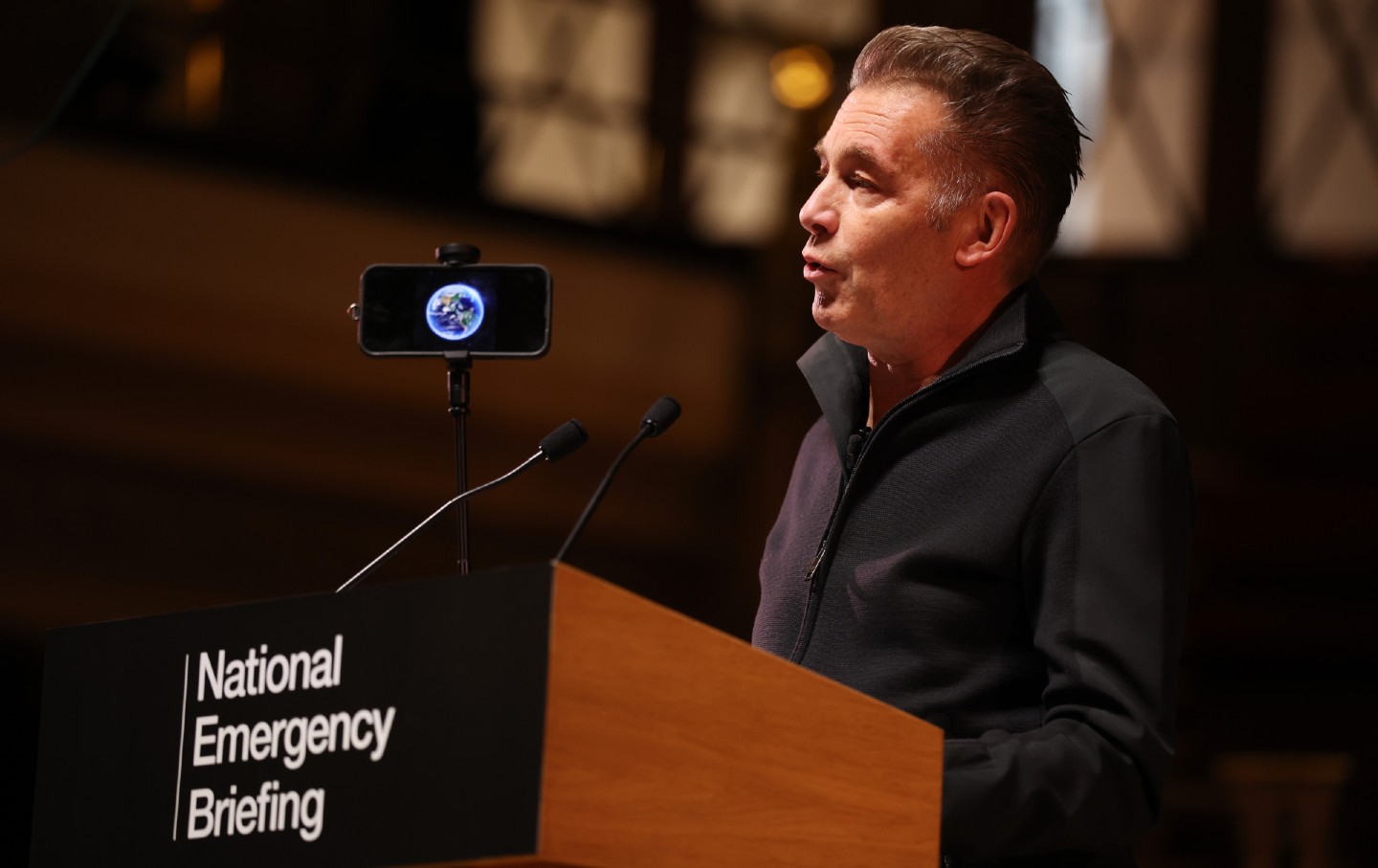Our Buildings Were Built for a Different World
The climate crisis demands that we retrofit them—which won’t happen at scale until architects start seeing themselves as political actors.

As an architecture critic, I’ve always maintained that the climate crisis cannot be tackled with flashy rhetoric, buildings with showy greenery, or glossy renderings of ecomodernist utopias that will never be built. The field’s most meaningful efforts to combat climate change are actually quite mundane. We need to retrofit the existing building stock with better insulation and ventilation, eliminate fossil fuels in the built environment, and reduce the immense pollution that buildings already emit (energy use in residential buildings accounts for 37 percent of all emissions in New York City).
New York has, in the last few years, made tremendous progress in its battle against building pollution. But thanks to the ever-circling vultures of the real estate industry, that progress is under threat. When New York City Local Law 97 (LL97) was passed in 2019, it was hailed as a kind of “Green New Deal” for the city level. The law sets climate pollution limits on buildings over 25,000 square feet, with the goal of reducing the buildings’ emissions by 40 percent by 2030 and to net zero by 2050. The concept of building pollution may not seem as intuitive as pollution from transportation and industry, but essentially it’s the same. It comes primarily from two places: the building’s own furnace system and the burning of fossil fuels for electricity.
Many buildings are made to devour energy, from 19th-century constructions originally outfitted with coal-burning stoves to mid-century builds that evidence the high-modernist turn toward centralized climate control. For much of history, energy sourcing and costs—and later climate change—weren’t matters of burning (ha) concern. Since the environmental crisis of the 1970s, architecture has become more and more invested in creating systems of environmental regulation toward energy efficiency, such as LEED ratings, an international green building certification program, or the Net Zero Energy and Passivhaus standards, which prioritize construction methods that use as little energy as possible. But there are so many buildings that were built for a different world that simply need to be made more livable.
I can speak from experience: My Chicago apartment, built in the 19th century, is insulated with nothing but newspaper, and the gas bill for heating (which I have to pay myself) is extremely high in the brutal winters. Electrification and insulation upgrades would both lower my heating bill and pollute less. It’s extremely simple. Something like LL97 would do wonders for all of our cities, because without the threat of huge fees for noncompliance, landlords and property management companies aren’t going to spend the money to do those upgrades. While a 100 percent reduction in carbon by 2050 sounds dramatic, it’s not even that hard to implement. The proof is in the numbers: When LL97 was passed in 2019, 20 percent of NYC’s large buildings were so polluting that they were over the law’s initial 2024–29 emissions limit. Now, it’s only 10 percent. Half of buildings cut pollution below the first pollution limit a full two years before they had to. Ninety percent of buildings have already met the law’s 2024 benchmarks, and about 30 percent of large buildings already meet the law’s 2030 limits. Bullying works!
But here’s the thing: The political climate in which LL97 passed is not the same one we’re living in now. And the progress it’s already made is in danger. The Supreme Court’s disastrous Chevron ruling has severely curtailed the federal government’s ability to regulate. In 2023, when New York became the first state in the country to pass a law banning the use of fossil fuel equipment in new construction, only four months passed before fossil fuel industry groups filed a lawsuit to block it, following the example of a lawsuit that successfully thwarted a similar bill in California. LL97 itself is under threat: Mayor Eric Adams, always a friend to the real estate industry, has already granted two loopholes, one that allows building owners to apply for a two-year delay on fulfilling the bill’s requirements and another that extends the option to purchase “renewable energy credits” instead of funding renovations. Now, via Councilwoman Linda Lee’s cynical and vague Intro 772, the real estate lobby’s coming for a third: an exemption from the law’s provisions for condo and co-op building owners. LL97 targets large buildings. Make no mistake: Residential buildings don’t just stop polluting because people are living there instead of companies.
If these loopholes keep passing, the fate of LL97 won’t be so different from that of congestion pricing, which Governor Kathy Hochul shockingly rolled back at the last minute. As the fight to protect LL97 ramps up, we should take warning from Hochul’s chosen deflection: She claims that humble folks at the diner support her about-face—which is really just a cover for suburban car-brained small-business owners. Her weapon of choice is faux-populism, extolling the little guy while her policy harms the majority of New Yorkers who use public transit. Pete Sikora, a spokesperson for New York Communities for Change, an organization that works primarily with low-income communities of color, told me bluntly that Hochul can invoke average New Yorkers all she wants, but “average New Yorkers drowned in their basements during Hurricane Ida.”
There’s a connection between Hochul’s (imagined) diner-goers and the appalling appearance of Teamsters president Shaun O’Brien at the Republican National Convention, where he made populist overtures against “big-money think tanks.” Right-wing unionism also comes into play in the gas bill lawsuit. According to City Limits, Mario Mattera, a Republican New York state senator—and president of the Plumbers Local Union No 200—is working directly with myriad aggrieved business owners and lobbyists at the American Petroleum Institute in New York to stop the bill. Their argument is that electrification will take plumbing jobs. This sure seems like a red herring, given that built-environment climate bills create jobs; LL97 alone is estimated to create a whopping 141,000 of them. It takes a lot of work to retrofit an entire skyscraper! Additionally, as any union member knows, the actions of the union president don’t always align with those on the shop floor. Many Teamsters (including John Palmer, the vice president at large, who called the speech “embarrassing”) and other allied labor leaders decried O’Brien’s participation at the RNC. The Teamsters’ own social media account went rogue during his speech, accusing him of throwing queer and minority Teamsters under the bus by teaming up with Trump and speaking before a crowd full of “Mass Deportation Now” signs—not union-printed, by the way. The tweets have since been deleted.
As efforts to erode democracy accelerate at the highest levels of government, it’s clear that if we want to win on climate, win against the oil and gas industries, win in architecture (which is touched by all of this), and thereby win as tenants and workers and as the dwellers of buildings and Mother Earth alike, the only way forward is to organize. People, frankly, are pissed. Fliers reading “KATHY HOCHUL MADE YOUR TRAIN LATE!” went up all over the subway after she abandoned congestion pricing. On July 18, over 500 people from a broad coalition of community and activist groups, including New York Communities for Change and Food and Water Watch NY—both instrumental in passing New York’s recent anti-fracking legislation—showed up for a town hall at the New York Society for Ethical Culture to push back against Intro 772. They also put pressure on Hochul to sign the Climate Superfund Act, which would force the fossil fuel industry to pay $3 billion a year to help pay for resiliency and other projects related to climate damage. (“Basically free money,” Sikora described it.)
Organizing at the community level and putting pressure on politicians can go a long way, but it’s not enough. Architects have to start seeing themselves as political actors with high stakes in the same way communities and unions do. Architects are workers and they depend on work. Architecture projects have stagnated and work has dried up. Not to be vulgar, but these climate bills are extremely good for architects. The American Institute of Architects—a flawed organization, but the only representative one for the field—supported LL97 for this reason. The fight for climate justice, resiliency, and workers’ and tenants’ rights are only going to get harder in an era of political decay, cronyism, and systemic crisis. Laws like LL97 were a victory of the long 2010s. But it’s going to take more than the law to keep them on the books in the even longer 2020s.
Disobey authoritarians, support The Nation
Over the past year you’ve read Nation writers like Elie Mystal, Kaveh Akbar, John Nichols, Joan Walsh, Bryce Covert, Dave Zirin, Jeet Heer, Michael T. Klare, Katha Pollitt, Amy Littlefield, Gregg Gonsalves, and Sasha Abramsky take on the Trump family’s corruption, set the record straight about Robert F. Kennedy Jr.’s catastrophic Make America Healthy Again movement, survey the fallout and human cost of the DOGE wrecking ball, anticipate the Supreme Court’s dangerous antidemocratic rulings, and amplify successful tactics of resistance on the streets and in Congress.
We publish these stories because when members of our communities are being abducted, household debt is climbing, and AI data centers are causing water and electricity shortages, we have a duty as journalists to do all we can to inform the public.
In 2026, our aim is to do more than ever before—but we need your support to make that happen.
Through December 31, a generous donor will match all donations up to $75,000. That means that your contribution will be doubled, dollar for dollar. If we hit the full match, we’ll be starting 2026 with $150,000 to invest in the stories that impact real people’s lives—the kinds of stories that billionaire-owned, corporate-backed outlets aren’t covering.
With your support, our team will publish major stories that the president and his allies won’t want you to read. We’ll cover the emerging military-tech industrial complex and matters of war, peace, and surveillance, as well as the affordability crisis, hunger, housing, healthcare, the environment, attacks on reproductive rights, and much more. At the same time, we’ll imagine alternatives to Trumpian rule and uplift efforts to create a better world, here and now.
While your gift has twice the impact, I’m asking you to support The Nation with a donation today. You’ll empower the journalists, editors, and fact-checkers best equipped to hold this authoritarian administration to account.
I hope you won’t miss this moment—donate to The Nation today.
Onward,
Katrina vanden Heuvel
Editor and publisher, The Nation








